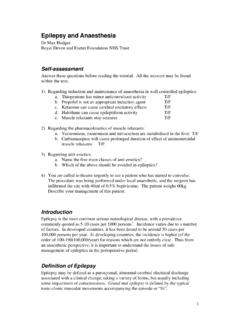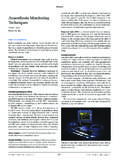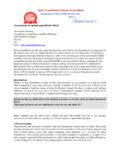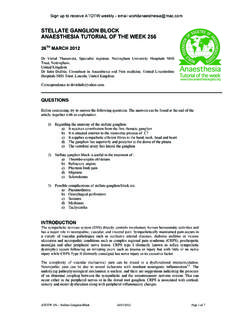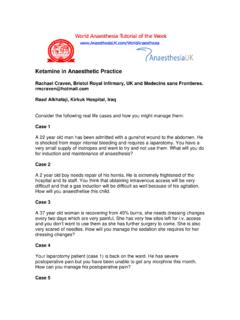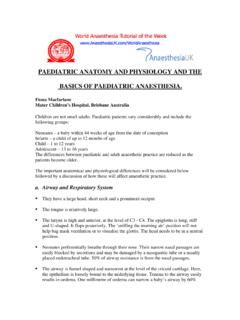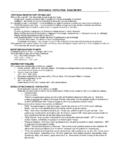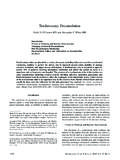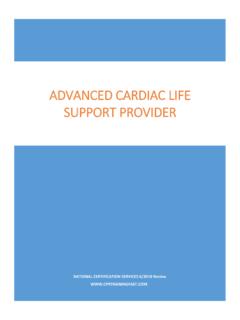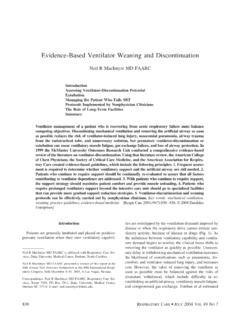Transcription of ACUTE RESPIRATORY DISTRESS SYNDROME (ARDS)
1 ACUTE RESPIRATORY DISTRESS SYNDROME ( ards ) Author Dr D. Lacquiere Correspondence: Please answer the following questions before reading the tutorial. The answers are contained in the article. 1. A 70-year-old man with ischaemic heart disease has been in hospital for two days following a road traffic accident in which he sustained injuries to his spleen, bowel and several long bones. He has become markedly short of breath. What further information would you seek to make a diagnosis of ards ? 2. Describe the pathological processes occurring in the lungs of a patient with ards that can lead to a.
2 Shunt b. Deadspace c. Decreased compliance 3. ards is diagnosed in the patient in question 1. He has now been ventilated in the ICU for 3 days. You are called because the PaO2 has decreased and the airway pressures have increased. The nurse mentions that RESPIRATORY secretions have become purulent. Describe the procedures / investigations you might carry out. 4. A 70 kg patient with ards is being ventilated with the following settings and arterial blood gases. Which if any would you consider changing, and why? Tidal volume 650 ml FiO2 Plateau pressure 35 PEEP 10 cmH2O PaO2 9 kPa PaCO2 kPa pH 5.
3 A 60 kg patient with ards is receiving volume-controlled ventilation with the following settings: Tidal volume 450 ml FiO2 Plateau pressure 35 cmH2O PEEP 15 cmH2O PaO2 remains less than 8 kPa. What ventilatory strategies would you consider to improve the PaO2? Which if any have been shown to improve survival? 6. What are the disadvantages of using pressure-controlled inverse-ratio ventilation? Introduction First described in 1967, ards is a process of hypoxaemic RESPIRATORY failure associated with non-cardiogenic pulmonary oedema.
4 It is the result of diffuse inflammatory damage to the alveoli and pulmonary capillaries from a range of local or systemic insults. ards is often associated with multiple organ dysfunction and carries a high mortality and financial cost. Definitions ards is diagnosed on clinical grounds. The most commonly used criteria were produced by the 1994 American-European Consensus Conference1. ACUTE onset Appropriate precipitating condition New bilateral fluffy infiltrates on chest x-ray (CXR) No clinical evidence of cardiac failure, fluid overload or chronic lung disease Pulmonary artery occlusion pressure of 18mmHg Pa02/Fi02 ratio of 200mmHg (27kPa) ACUTE Lung Injury (ALI) is a less severe form of ards in which the Pa02/Fi02 ratio is 300mmHg (40kPa).
5 Note that the Pa02/Fi02 ratio is independent of PEEP. As pulmonary artery catheters are used rarely in our ICUs now the occlusion pressure 18 is often not sought and clinical grounds or echocardiography used to exclude cardiac failure. Epidemiology The true incidence of ards is unknown; estimates vary depending on the definitions used, with values ranging from per 100 000 population per year to 75 per 100 000 population per year. Recent data from an Australian study which used the 1994 consensus conference definition for ards would suggest that one in ten non-cardiothoracic ICU patients will develop ards .
6 Although ards may affect children it is more common in those over the age of 65, which may reflect a higher incidence of predisposing conditions. Gender has no effect. In recent years mortality rates have decreased from about 60% to 30-40% but mortality is higher in the elderly and in patients with factors such as chronic liver disease. Most of those who die do so from sepsis or multiple organ failure and not from RESPIRATORY failure. Survivors usually have little in the way of pulmonary sequelae, although the severest cases may have restrictive lung disease Precipitating conditions Theses can be classified as direct or indirect Direct Indirect Pneumonia Multiple trauma Lung contusion Massive transfusion Aspiration of gastric contents Sepsis Fat embolism Pancreatitis Toxic inhalation Cardiopulmonary bypass
7 Near drowning Burns Reperfusion injury Bone marrow transplant Drugs and toxins Pathophysiology It is not understood why some individuals develop ards /ALI while others with the same pattern of predisposing injury do not. In those that do there are said to be three overlapping phases2: an inflammatory phase, a proliferative phase and a fibrotic phase caused by the subsequent reparative response. Patients with ards /ALI do not have to progress through all three phases as resolution can occur at any point. However, the severest form of ards will progress to the fibrotic phase.
8 Inflammatory phase This lasts for one week after the onset of RESPIRATORY failure. Neutrophils accumulate in the capillaries, interstitial tissue and airspaces, and cause cell damage through the production of free radicals, inflammatory mediators and proteases. However neutrophils are not the only cell type involved as ards does occur in neutropenic patients. Cytokines (most importantly TNF- , IL-1 IL-6 and IL-8) are also released by endothelial and immune cells and promote similar microvascular damage. The result is leakage of fluid and plasma proteins into the alveoli and interstitial tissues ( non-cardiogenic pulmonary oedema ), while at the same time the plasma proteins denature alveolar surfactant causing alveolar collapse.
9 This creates hypoxia as the fluid-filled alveoli shunt blood. Shunt is created when areas of lung receive a blood supply but are unable to oxygenate it (in this case by creating a diffusion barrier.) To complicate matters further vasoconstriction and occlusion of pulmonary capillaries by neutrophils, platelets and fibrin also occurs leading to areas of lung that are ventilated but not perfused deadspace. The increase in total lung water also stiffens the lung (decrease in compliance) and this dramatically increases the work of breathing.
10 Proliferative phase This phase is characterised by proliferation of type II pneumocytes and fibroblasts, with the formation of hyaline membranes. However, these pneumocytes do not make any surfactant and total production of surfactant decreases (this exacerbates the loss of surfactant caused by protein denaturing.) Fibrotic phase Disordered collagen deposition occurs, leading to extensive lung scarring. This makes the lung stiffer and further increases the work of breathing. This can be severe enough to make it impossible to wean the patient from a ventilator but normally it is a matter of restoring the patients muscle strength to the point where they are able to cope with the increased effort required.
